|
Table of Contents |
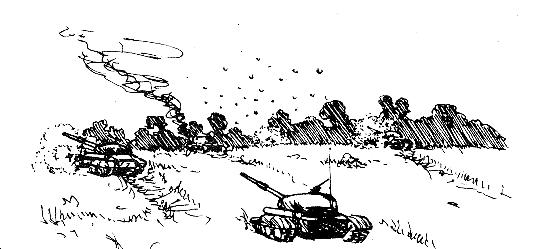
Mines destroy, delay, disrupt, and channel enemy forces. They provide a very effective means of terrain control and casualty infliction on the enemy. Mine warfare systems are flexible. Compared with the costs of other weapon systems, mines are efficient and effective. However, their success and timely employment are factors of their availability and transporation assets to haul them.
This chapter discusses the classification and employment of various types of minefields which can be emplaced in the AirLand Battle; command and control of both conventional and scatterable mines to include employment authority; and the reporting, recording, marking, and warning procedures for conventional and scatterable mines.
MINEFIELD EMPLOYMENT AUTHORITY
REPORTING, RECORDING, AND MARKING
Minefields are classified by the purpose they serve. Types of minefields include protective, tactical, point, interdiction, and phony.
Protective minefields aid units in local, close-in protection. There are two types of protective minefields, hasty and deliberate.
Hasty protective minefields are used as part of a unit's defensive perimeter. They are usually laid by units using mines (conventional or scatterable) from their basic loads.
If conventional mines are used, they are laid on top of the ground in a random pattern. No antihandling devices will be used. They are employed outside hand grenade range but within small arms range. All mines are picked up by the emplacing unit upon leaving the area, unless enemy pressure prevents mine retrieval.
If scatterable mines are used for the purpose of hasty protective mining, the system most likely to be used is the Modular Pack Mine System (MOPMS). This system is man-portable and can be employed rapidly. The MOPMS container has both antitank and antipersonnel mines and is placed and aimed in the desired direction. If the unit determines that the mines should be employed due to enemy action, the box is explosively command-detonated and the mines scattered. Once employed, the mines cannot be retrieved. If the minefield is not required, the unit simply picks up the unexploded box and moves to a new location.
Deliberate protective minefields are used to protect static installations such as depots, airfields, and missile sites. Conventional mines are always used and are emplaced in standard patterns, usually by engineers. The field is always fenced, marked, and covered by fire. These minefields are usually emplaced for long periods. When these minefields are to be removed, engineers clear them.
Tactical minefields are emplaced as part of the obstacle plan. These minefields--
Tactical minefields are emplaced using conventional or scatterable mines. Density and depth of the minefield depend on the tactical situation. All types of mines and antihandling devices can be used.
Point minefields disorganize enemy forces and hinder their use of key areas. Point minefields are of irregular size and shape, and include all types of antitank and antipersonnel mines, and antihandling devices. They should be used to add to the effect of existing and reinforcing obstacles, or to rapidly block an enemy counterattack along a flank avenue of approach.
Interdiction minefields are placed on the enemy or in his rear areas to kill, disorganize, disrupt lines of communication and command and control facilities. Interdiction minefields are used to separate enemy forces and delay or destroy enemy follow-on echelons. Interdiction minefields are emplaced using air or fire support delivered scatterable mines.
Phony minefields, used to degrade enemy mobility and preserve our own, are areas of ground used to simulate live minefields and deceive the enemy. They are used when lack of time, personnel, or material prevents employment of actual mines. Phony minefield can supplement or extend live minefields, and may be used as gaps in live minefields. To be effective, a phony minefield must look like a live minefield by either burying metallic objects or making the ground look as though objects are buried. Phony minefields are of no value until the enemy has become sensitive to mine warfare.
The table below (Mine delivery methods and characteristics) relates mines to their methods of delivery, self-destruct features, and emplacement characteristics. It also identifies those mines which may or may not be placed in a classical pattern. This table provides a basis by which mines can be categorized as scatterable or conventional according to their self-destruct feature. The table below (Mine categories and characteristics) lists mines by category, and also provides additional characteristics of each mine.
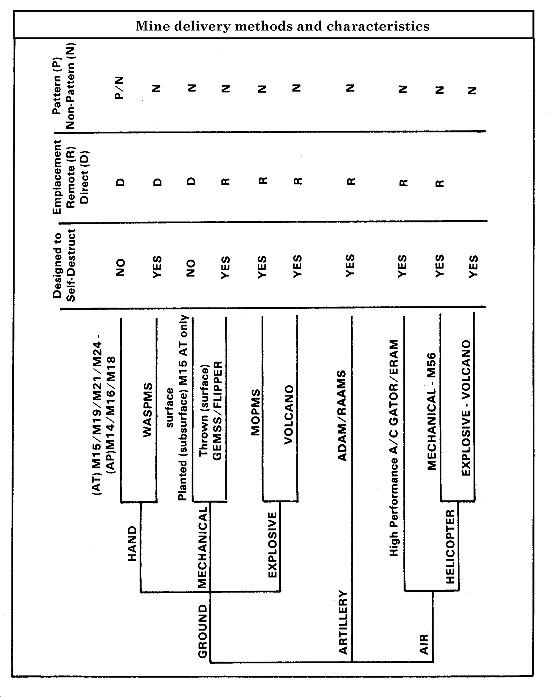
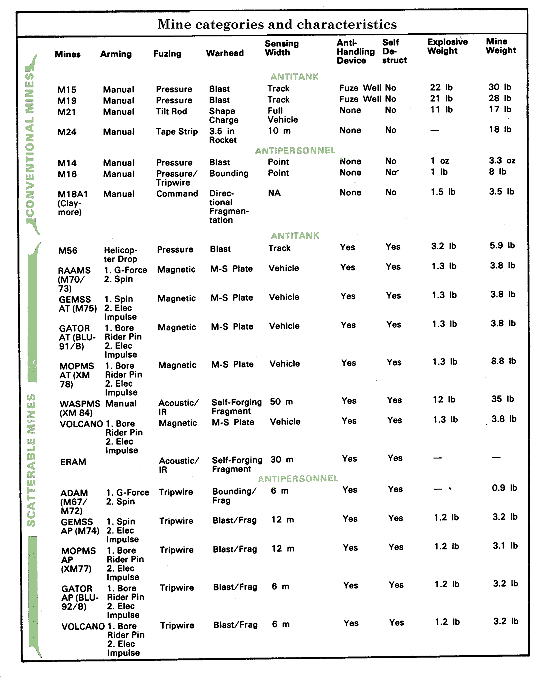
Mines are a significant combat weapon. Minefields are the most effective means of reinforcing the terrain to stop, slow, or channelize the enemy into areas where he can be killed. Minefields can and should be emplaced wherever and whenever the tactical situation dictates. The commander's flexibility in minefield employment has been expanded extensively with the fielding of multiple mine delivery systems. We can expect both conventional and scatterable minefields to be the principal countermobility asset. Conventional and scatterable minefields should be employed using the terrain analysis and obstacle planning sequence previously outlined. Conventional and scatterable minefield locations should be preplanned prior to the beginning of the battle, and emplaced when the tactical situation requires.
Mine warfare operations must complement the commander's plan for defense, avoid impeding friendly mobility, and facilitate future operations. The engineer is the commander's principal advisor in insuring that these objectives are met. To achieve success in mine warfare, both the commander and the engineer must carefully control mine employment. Commanders and staffs throughout the force must know and follow authorizations and requirements to emplace mines and report, record, mark, and coordinate minefields.
Detailed and integrated staff coordination is necessary to develop plans for mine warfare operations. Coordination begins with the development of a recommended obstacle plan to support the commander's scheme of maneuver and plan for fire support. Minefield are incorporated into the obstacle plan as necessary.
Preplanned conventional and scatterable minefields will be part of the obstacle plan developed for the commander by the engineer. The operations officer, fire support coordinator, aviation officer, and air liaison officer (ALO) will assist the engineer. Preplanning will consist of identifying areas for minefields to respond to possible enemy courses of action. Preplanning will facilitate rapid emplacement, especially for mines delivered by artillery, helicopter, and high-performance aircraft. In all cases, execution is a command decision of the responsible maneuver commander, who must select the delivery system that best fits the tactical situation and presents the least risk to friendly troops. Employment will be coordinated with higher, lower, and adjacent units prior to execution, and reported and recorded afterwards.
Conventional minefields will normally be emplaced prior to the beginning of hostilities due to the exposure of manpower and equipment, and due to the length of time necessary to emplace them. Once the battle begins, conventional minefields could still be emplaced but would have to be emplaced out of direct fire and, preferably, indirect fire range. Restriction to friendly maneuver or a rapidly changing battlefield is another very important factor to consider. Conventional minefields would rarely, if ever, be emplaced forward of the forward line of own troops (FLOT).
Scatterable minefields can and should be planned and emplaced throughout the battle-field as the tactical situation requires and assets allow. Some scatterable systems are better suited for specific areas of the battlefield than others. Ground scattering systems are best utilized for emplacing larger tactical minefields and rapid, small, point, or hasty minefields. These type minefields are usually emplaced in friendly controlled territory. Other scatterable systems such as Artillery, Gator, M56, and Volcano can be employed throughout the battlefield. Emplacing helicopter delivered mines in enemy territory does involve a great degree of risk to the aircraft and crew. Artillery and high-performance aircraft delivery systems can be employed anywhere, but are ideally suited to deliver mines into enemy controlled areas.
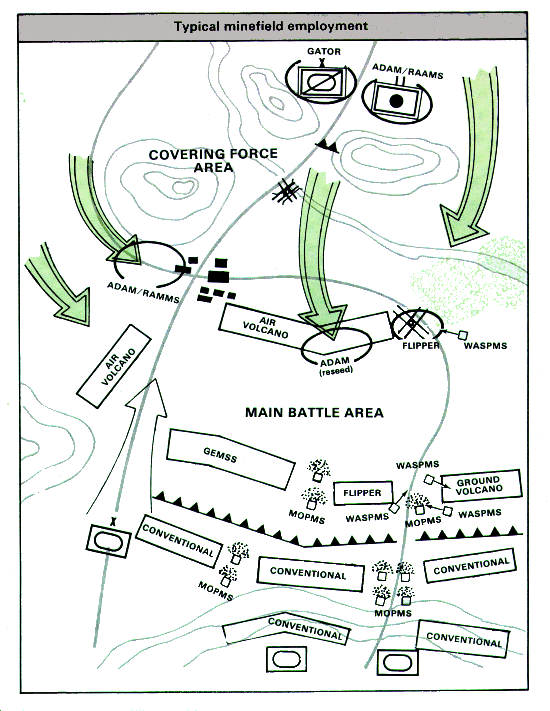
Employment of minefields must be carefully planned and emplaced in areas where the cost to the enemy would be greatest. The engineer must recommend, and the tactical commander must select, the type minefield and delivery system to accomplish that task. In recent wars, mines have accounted for a substantial portion of equipment and personnel losses. Current and future developments in mines and mine delivery systems are extensive, insuring that mines will be one of the most formidable assets on the battlefield.
The restrictions that minefields impose on friendly mobility, as well as enemy mobility, dictate the need for positive and effective command and control of mine employment. The echelon of command vested with the authority to emplace mines varies with the purpose of the minefield and type of mines (conventional or scatterable). Minefields that restrict maneuver to a greater degree require a higher echelon of authority. In all cases, the responsible commander must insure that the proposed field is coordinated with adjacent, higher, and subordinate units. The commander must further insure that limitations to friendly maneuver are minimized, and that all requirements for reporting, recording, and marking are met. Commanders may delegate approval authority to lower echelons as stated. Also, any higher echelon may retain emplacement authority from subordinate elements.
At the outset, the corps commander is the employment authority for all scatterable mines. There are many possible combinations of available options depending on the tactical situation and future plans. Some example options are:
The general guidance to be followed is the longer the self-destruct time of the mine, the higher the employment authority should be retained. This criteria will prevent mine employment from hampering future friendly offensive operations.
The authority level is based upon the type minefield, likely employment location, and impact on friendly maneuver. The areas of influence and interest for the tactical commander also provide a general reference for employment authority for scatterable mines.
The area of influence is an assigned area of operations wherein a commander is capable of acquiring and fighting enemy units with assets organic to or supporting the command. It is a geographical area, the size of which depends upon the factors of METT-T. It is assigned by higher headquarters and designated by boundaries.
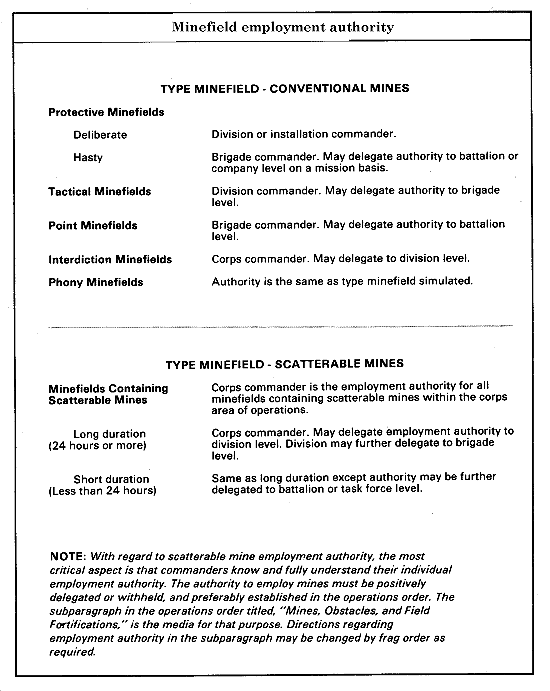
The area of interest extends beyond the area of influence. It includes territory which contains enemy forces capable of affecting future operations. The area of interest is usually within the next higher headquarter's, and a portion of adjacent unit's, area of influence.
Allocation of delivery resources provides an additional control for the employment authority. The means of delivery are related to the authority to employ. Before delegating authority, the commanders must consider their subordinate's concept of operation. Delivery systems available should be prioritized in allocation similar to other critical resources.
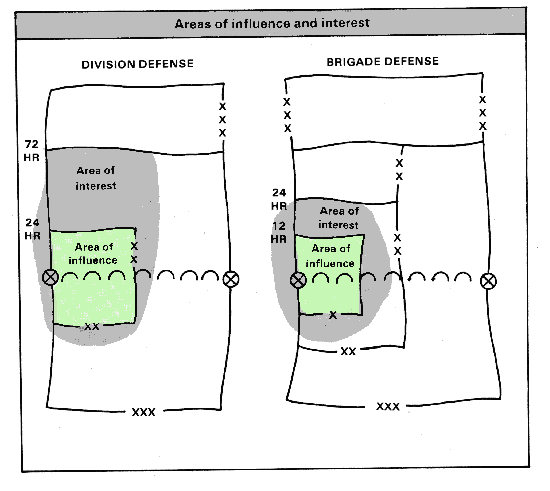
Once emplaced, minefields are lethal and unable to distinguish between friend and enemy. For this reason, positive control and a continuous flow of information is necessary. Reporting, recording, and marking of minefields must be performed using methods that are consistent and well understood. The basic differences between conventional and scatterable mines require that they be treated differently with respect to reporting, recording, and marking.
A minefield report is an oral, electronic, or written communication concerning mining activities, friendly or enemy. These reports document information on friendly and enemy minefields. The information is transmitted through operation channels and furnished to intelligence staff officers. It is then processed, integrated with terrain intelligence, and disseminated through intelligence channels to affected units. Mandatory conventional minefield reports are:
These reports will be submitted by the emplacing unit commander through operational channels to the operations officer (G-3/S-3) of the authorizing headquarters. That headquarters will integrate the reports with terrain intelligence and disseminate them through tactical intelligence. The reports should be sent by secure means.
The Report of Intention is made as soon as it is decided to lay the minefield. It doubles as a request when initiated at levels below those with authority to emplace. This report, when required, includes the following required data (Standardization Agreement (STANAG) 2036) on the proposed minefield:
Conventional minefields which are part of an operation or general defense plan that has been approved by the authorizing commander do not require a Report of Intention. Their inclusion in such a plan implies an intention to lay.
The Report of Initiation is a mandatory report made by the laying unit when installation begins. It informs higher head-quarters that emplacement has begun and the area is no longer safe for friendly movement and maneuver.
The Report of Completion is usually an oral report to the authorizing commander that the minefield is complete and functional. The Report of Completion is followed as rapidly as possible by the completed DA Form 1355 (Minefield Record) or DA Form 1355-1-R (Hasty Protective Minefield Record). Completion of the minefield records is the responsibility of the laying unit.
Additional reports may be required by the authorizing commander.
Progress Report
During the emplacing process, the commander may require periodic reports on the amount of work completed.
Report of Transfer
This is a written report which transfers the responsibility for a minefield from one commander to another. This report must be signed by both the relieved and relieving commanders. It must include a certificate stating that the relieving commander has been shown on the ground--or otherwise informed of--all mines within the zone of responsibility. It must state that the relieving commander assumes full responsibility for those mines. The Report of Transfer is sent to the next higher commander who has authority over both relieved and relieving commanders.
Report of Change
This report is made immediately to the next higher commander when the minefield is altered. It is sent through channels to the headquarters that keeps the written mine record. A Report of Change is made as soon as changes in any of our minefields occur. It is made by the commander responsible for surveillance and maintenance of the minefield.
All conventional minefields are recorded on DA Form 1355 (Minefield Record), except for hasty protective minefields, which are recorded on DA Form 1355-1-R (Hasty Protective Minefield Record).
Preparing the standard minefield record form is the responsibility of the laying unit. The officer in charge of the laying must sign and forward it to the next higher command as soon as possible. Once the information is entered, the form is classified SECRET or NATO SECRET, as required. The number of copies prepared depends on the type of minefield and local procedures. Unit standing operating procedures (SOPs) should provide for information on minefields being passed to higher and lower command levels, and laterally to adjacent units. When the record is made, it should be reproduced at the lowest level having the necessary equipment to make copies. Minefield records are circulated on a "need to know" basis. When used for training, they are marked SPECIMEN. Large minefield are recorded on two or more DA Forms 1355.
Whenever any changes are made to an existing minefield, a completely new record must be prepared on DA Form 1355. This record is marked REVISED and shows the minefield as it is after the changes. The original minefield number remains unchanged. Some changes which require a new record are:
Overlay
An overlay should be used when the minefield is to be related to operational maps. Standard military symbols are used in preparing mine warfare overlays.
Aerial photographs
Minefields can be recorded by aerial photographs if strip centerline tapes are kept in place until the camera work is done and prominent terrain points can be located. Aerial photographs can be used in conjunction with DA Form 1355 and attached to the completed form.
Measuring azimuth
Any type of angle-measuring device that can be oriented in reference to magnetic North can be used to lay out or plot mines.
Conventional minefield records are forwarded through operational channels to theater Army Headquarters where they will be maintained on file by the theater engineer. Minefield records may be maintained on file with the Assistant Corps Engineer in whose area of operation the minefield is located, if deemed necessary.
Minefields are marked as necessary to protect friendly forces. Standardization Agreement (STANAG) 2889 is the authoritative reference for marking conventional minefields emplaced by NATO forces. Normally, protective and tactical minefields will be fenced to protect friendly troops, noncombatants, and domestic livestock. In rear areas, minefields will be fenced on all sides. Two-strand barbed wire or concertina fences with signs are minimum protection. The Hand Emplaced Minefield Marking Set (HEMMS) may also be used as a marking means. Lanes will be marked using standard minefield marking sets. In forward areas, minefields will normally be marked only on the friendly (rear) side, or on the friendly side and the flanks. Lanes will be marked inconspicuously using wire, tape, rope, or easily identifiable terrain features. Minefield markings may be removed upon withdrawal. Point and interdiction minefield are not normally marked.
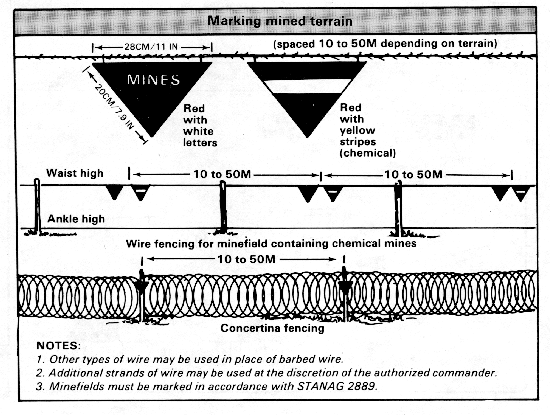
Shown below is a synopsis of conventional minefield reporting, recording, and marking procedures.
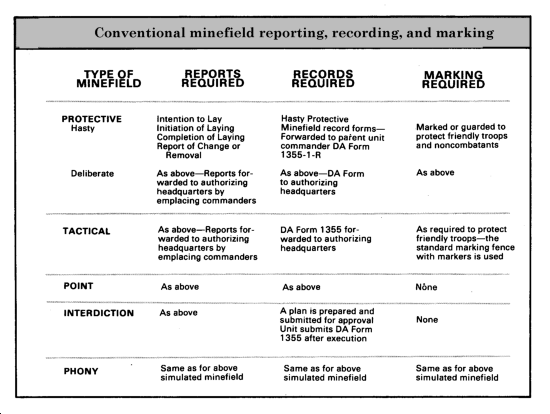
Accurate, timely, and uniform reporting and dissemination of scatterable minefield emplacement information is a must. Fluid and fast moving tactical situations require that complete information on scatterable mine employment be known and passed on in a simple and rapid manner to all units that could be affected. The variety of emplacing systems and emplacing units precludes the use of locally devised reporting and dissemination methods. Scatterable minefields must also be recorded to facilitate clearing operations after the war is over. They need not be recorded in the detail required when emplacing conventional mines. Since the locations of individual scatterable mines are unknown, they cannot and need not be plotted as are conventional mines. The aim points or corner points and the type mines emplaced is basic information which must remain on file for future reference and use.
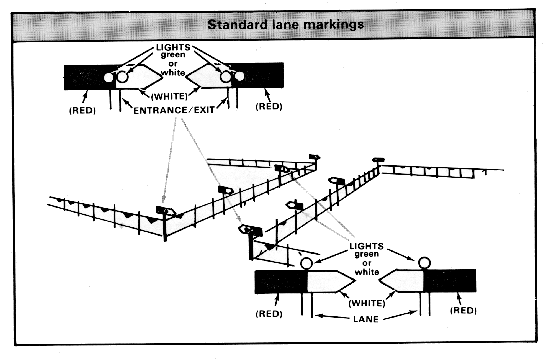
Shown in the illustrations below is a relatively simple reporting and recording procedure that will be used for scatterable mines. It is applicable for all delivery systems and can be sent in a voice, digital, or hard copy mode. This procedure is based upon the various types of emplacing systems. Some systems such as Artillery, Gator, and MOPMS are point oriented with the safety zone calculated from one or more aim points. Other systems such as GEMSS and the M56 have distinct minefield corner points which must be reported. The basic purpose of this procedure is to provide one method that is uniform with all basic information required to report and maintain a record of scatterable mine employment. This procedure also contains all the information necessary to warn units which may be affected. Warning information can easily be extracted and disseminated to units which require it.
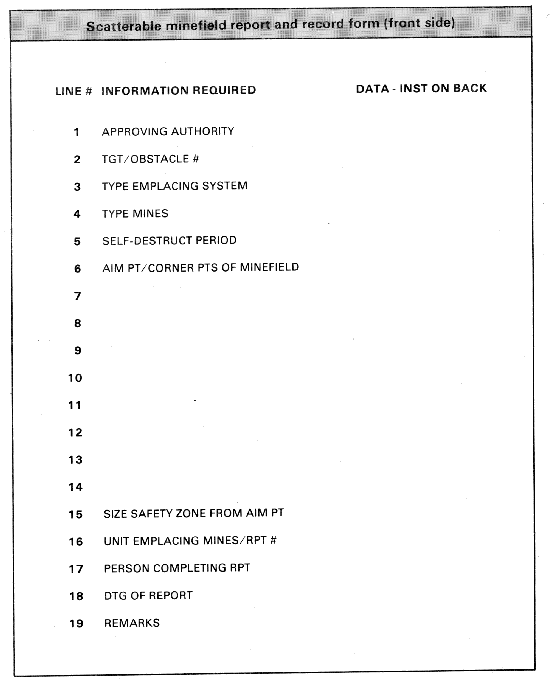
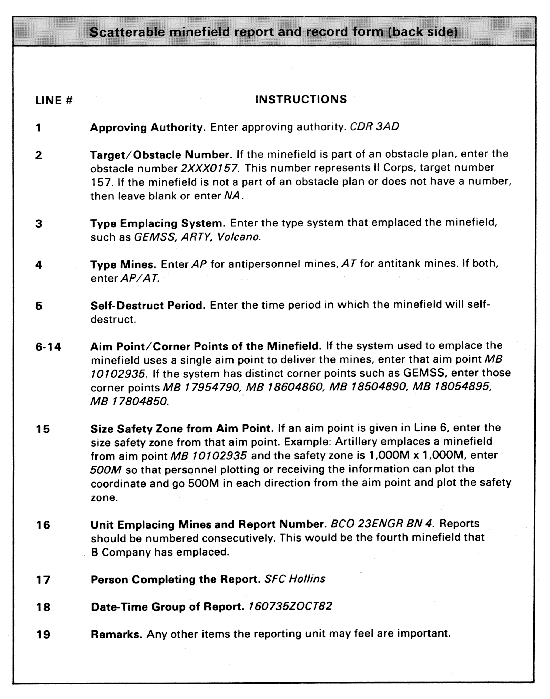
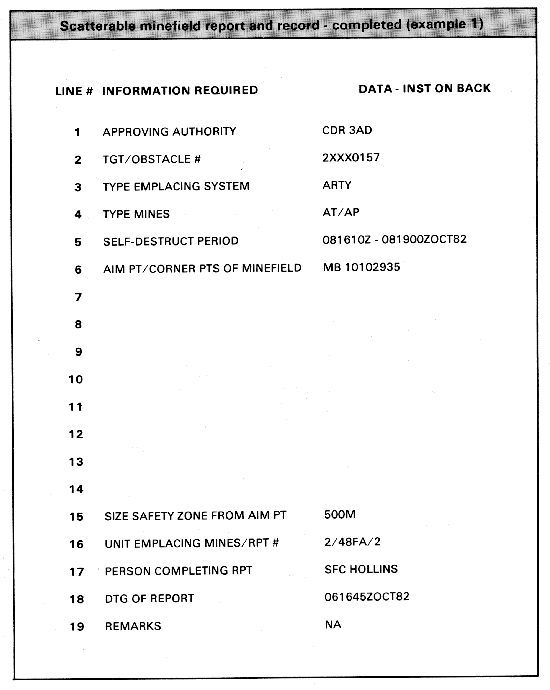
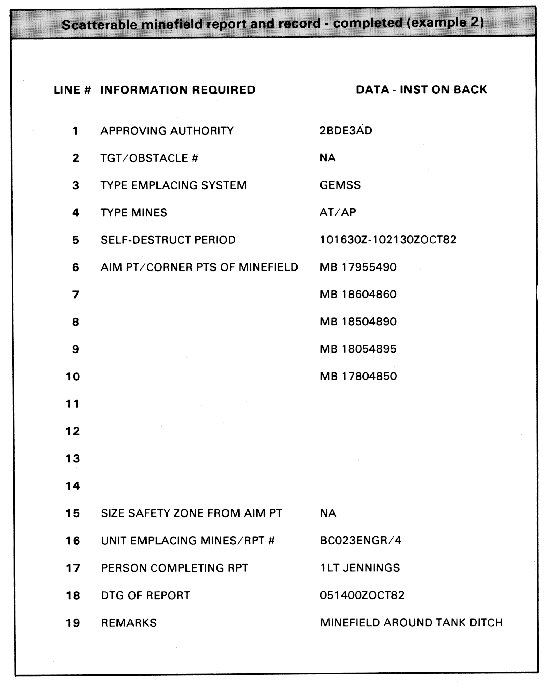
The unit emplacing the mines will immediately report the pertinent information required by the most expeditious secure means. If the initial report is not a hard copy report, the emplacing unit will prepare the report in hard copy as soon as possible. The report is sent through operations channels to the headquarters authorizing the minefield. The information is posted on operations maps and disseminated to units that are affected. The report is then forwarded in the same manner as the conventional minefield record to the senior engineer in the theater for permanent retention. Forwarding the hard copy report to the theater commander is not time sensitive. Reports can be batched and forwarded when time permits.
Units which may be affected by the emplacement of scatterable mines will need to receive a warning to alert them. This warning message may be disseminated prior to or after the mines are emplaced. Only the very basic information should be included to prevent tie up of communication systems. The following procedure is a convenient and easily sent message which provides all the necessary information.
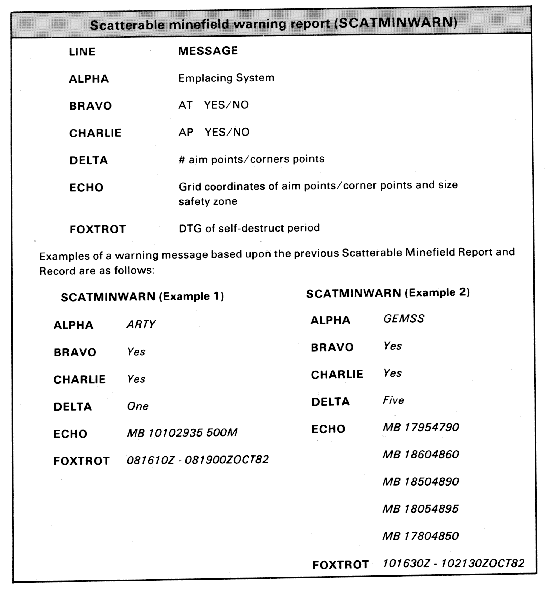
Scatterable minefield employment planning, reporting, and recording requirements and responsibilities vary according to the type emplacement system. Listed in the tables below are the basic responsibilities of key command, staff, and units in the planning and employment of scatterable mines. These responsibilities and actions are based upon the system emplacing the minefield.
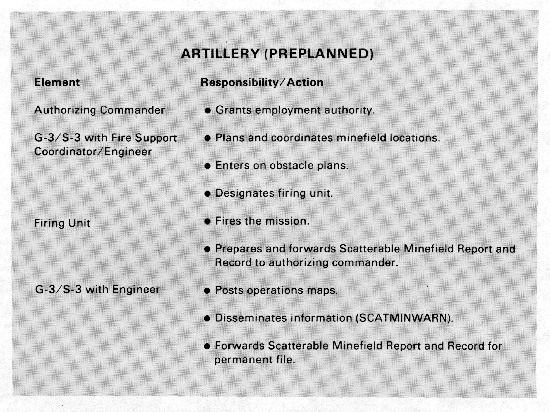
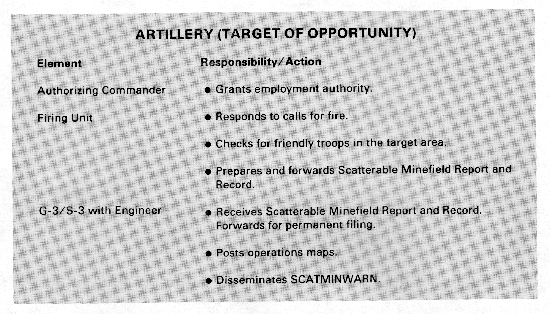
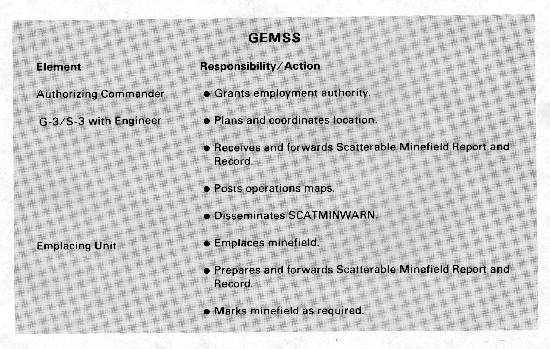
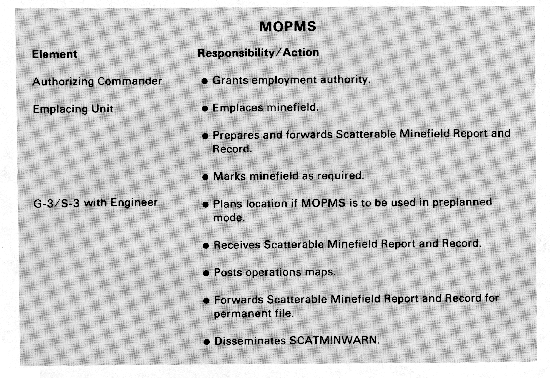
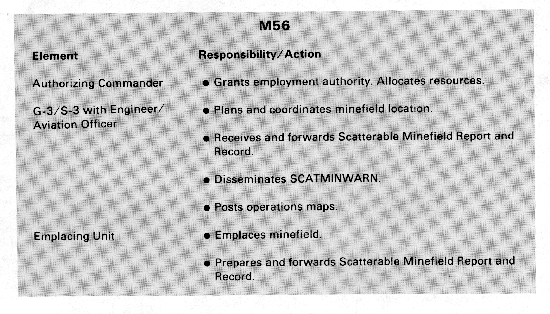
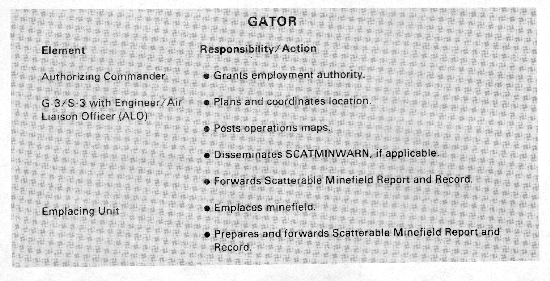
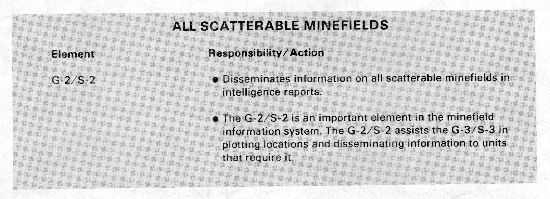
The capability of remotely and rapidly emplacing scatterable minefields throughout the battlefield presents a real problem with regard to marking. Scatterable minefield marking may be unnecessary or impossible in many cases. Scatterable mines emplaced in enemy territory are a prime example.
Scatterable minefields must be marked to the extent necessary to protect friendly troops. Those emplaced in friendly territory should be marked according to standard marking procedures. Those emplaced in forward areas are marked on the friendly side and the flank. Minefields emplaced in rear areas are marked on all sides.
There is not a specific marking system available for marking scatterable minefields. The standard marking procedure described earlier in this section can be used for some scatterable systems such as the GEMSS and M56 which have specific and known limits. Other systems have less definable limits and normally will not be marked due to their employment in enemy territory.

Any detection, encounter, or knowledge of enemy minefields or mining activities must be reported by the fastest reliable means. The report is made to the next higher commander, and must include all known information about the minefield. The report is normally made through operations channels. Specific information and format of that information is outlined in STANAG 2096 and is as follows.
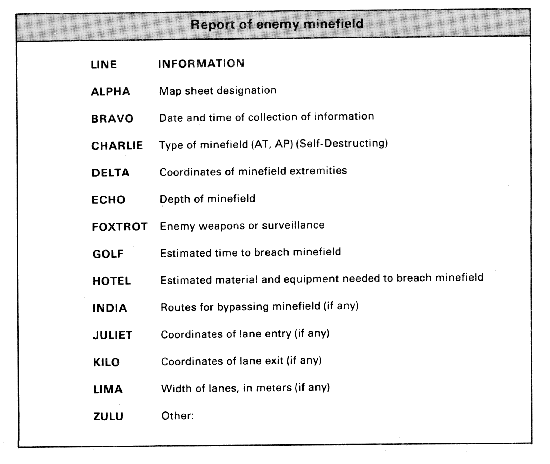
Conventional minefield key points
Minefields are classified as:
Protective.
Tactical.
Point.
Interdiction.
Phony.
There are three mandatory minefield reports:
Report of Intention to lay.
Report of Initiation of laying.
Report of Completion of laying.
There are two minefield record forms:
DA Form 1355 (Minefield Record).
DA Form 1355-1-R (Hasty Protective Minefield Record).
Minefield sites are chosen with the primary purpose of blocking, channeling, and killing the enemy.
Lanes and gaps in minefields are used for the safety of our own troops. Minefield plans must be coordinated with adjacent units and plans for patrols, supporting fires, counterattacks, withdrawals, and logistic support.
Scatterable minefield key points
Establish employment authority in the operations order.
Plan potential scatterable mine locations early.
Emplace scatterable mines based upon enemy disposition and friendly mobility plan.
Report scatterable mine locations rapidly.
Disseminate information to affected units.